My river keel design is still my go to since I primarily hunt moving water, however I use a variety of keels since my decoys tend to be a little extreme sometimes as far as poses go. I don't really worry too much about self righting since I don't throw my decoys, I just want them to stay upright and float level regardless of wind and waves. Several of my pack in decoys have no keels at all and weigh 8 or 9 oz., I use mesh bags that I put rocks in for weights when I get to my destination. I've even used gravel for weight, but in Idaho, usually rocks are never in short supply.
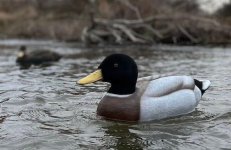
I can't look at this picture without thinking about how many rainbow trout are under this decoy. I always have a fly rod when duck hunting.
This is the same mallard decoy and the mesh bags. You probably noticed that I don't paint my mallard heads green, I want as much flocked black as I can get in my decoys.
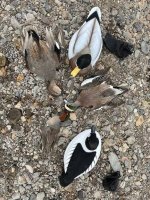
On some taller poses I use stacked keels made from composite decking. Basically 1"x1"x 8" pieces. The first is embedded flush, a second is screwed in with deck screws and if a third is needed to counter balance the height of this gadwall decoy, I'll add another. I have a little water feature pond right outside the shop door where I can test float all the decoys. I'm not real sure how many of my decoys ever see water when I ship them somewhere, but when they leave the shop, they are ready to hunt.
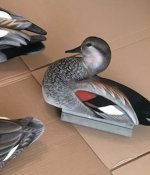
Another keel design I use is the full body floater internal belly keel. I make a lot of urns and just felt like an urn should be a piece of artwork and have a place of honor. However lots of requests are made for a decoy that can be hunted a time or two a year. I use an amount of ashes placed in the belly of the full body floater in such a way to make it self right and float properly like this hooded merganser. There is a hook up for the decoy cord embedded in the belly about where the front of the flank ends. The feet are immaterial to the design.
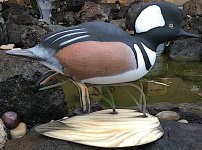
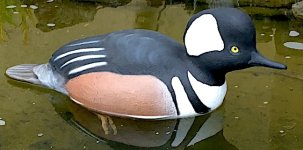
This last keel is something new, it's about 2.5 inches wide and roughly the length of the footprint of the decoy. As I mentioned, I think a lot of my decoys end up on display, but they leave the shop ready to hunt. This keel offers self righting and sits flat during the offseason. it would sit flat when your water levels go down.
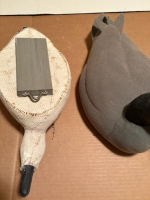
I do concern myself with keel weight a lot, that's why my personal decoys are often no keel and pretty standard poses. My six slot decoy bag, fancy pack frame, two buckets to sit on and maybe 8 decoys weigh 15 pounds. my concern isn't the weight packing in, it's the weight of 14 ducks being added to it and packed out, however at my age, my son is doing all the packing out duties.






